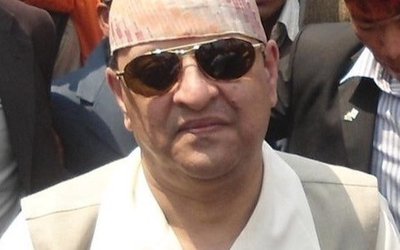Our intelligentsia and planners are virtually unaware of the true significance of the findings from the past studies of our water resources projects, as a result the vast economic potential of the projects, like the Upper Karnali Project, Sun-Kosi Project, Burhi-Gandaki Project etc. is grossly underestimated.
Kathmandu valley would continue to suffer from acute water supply shortage in dry season even after coming into operation the Melamchi Water Supply Project.
Super high-head Langtang Multipurpose Hydropower Project apart from generating extremely cheap electricity could be implemented to supply simultaneously abundant water for free to Kathmandu valley.
Langtang river water diverted through the hydropower station would be discharged into the Melamchi river.
The augmented flow of the Melamchi would be automatically delivered into Kathmandu valley by using the surplus capacity of the Melamchi Project tunnel.
Langtang Melamchi Interconnection
At present Kathmandu valley is suffering from acute water shortage. Ever increasing mining of the ground water in the valley is greatly feared to have disastrous environmental consequences. According to the UNDP report the additional water supply from the long awaited Melamchi project is going to be insufficient to meet the demand for water in the valley.
Surplus carrying capacity of the 28 km long Melamchi tunnel could be used to divert into the Kathmandu valley the abundant Langtang river water for free and also to generate amazingly cheap electricity. The proposed project could also help to flush the Bagmati river out with enough clean water drawn from the Langtang even in dry months. Thus the pollution of this holy river could also be significantly controlled.
German Concept of Langtang River Diversion
The diversion of the Langtang river for water supply to Kathmandu valley is not a new concept. A study of such diversion was made by GTZ in 1977.
The idea to augment the limited water resources of the Kathmandu valley by diversion of water from the Langtang / Gosaikund massif in the North was first mentioned by Peter Aufschnaiter in 1960. In 1976 /77 the project was studied on a very preliminary level by Dr. Ing. Cristian Kleinert.
The above mentioned project, originally not listed by HMG of Nepal under the projects to be investigated for possible cooperation with the Germany had been included into the study programme on the initiative of the German Government Mission itself because of the fascinating concept and promising objects. The Mission report points out that at that time the high cost of the project mainly caused by difficult access and transportation would not make it viable to undertake it for further detailed study.
Fortunately, now the road situation has greatly improved. The decision to build the 28 km long Melamchi tunnel with a capacity to carry a flow of about 15 cubic meters/ sec in order to divert only about 2 cubic meters/sec Melamchi flow into Kathmandu valley during critical dry season months has radically altered the situation and made the Langtang project for power generation perhaps the most attractive project for implementation in very near future since the intake of the Melamchi tunnel is not too far away from the Langtang river. It is obvious that the diversion of the Langtang river water into the Kathmandu valley would not involve additional investment once the hydropower project is built.
UNDP Helped Gandak Basin Study
The concept of the Langtang project solely for power generation was developed under the UNDP supported Gandak basin master plan study . That concept requires some revision to include the component of water supply to Kathmandu valley. As a result, it necessitates discharging the regulated Langtang water after power generation into the Melamchi river instead of the Bhotekosi (Trisuli) as envisaged in the UNDP study.
Langtang Storage Reservoir
The hydropower generation potential of the Langtang river is significantly enhanced by the possibility to provide a relatively large storage reservoir to be located at a very high altitude. The volume of the reservoir according the UNDP study report could be about 180 million cubic meters. It can be planned to provide all through the year an uniform flow of about 10 cumecs in the middle and lower reaches. A head of about 1500 meters could be utilized for power generation.
Revised Hydropower Stations Planning
According to the Gandak Basin Master Plan a 120 m high dam, as mentioned before, has been proposed on the Langtang Khola near Jaithang.
There would be a diversion barrage across the Langtang river at Ghore Tabela about 15 kms downstream the proposed high dam to draw water for power generation.
Water stored in the Langtang river reservoir and also the flow from the catchment downstream storage dam would be drawn into the headrace tunnel of the Langtang hydropower station.
The length of Langtang hydropower tunnel discharging the water after power generation into Melamch river ( instead of Bhote-Kosi according to Gandak Basin Master Plan) would be about 20 kms.
The installed capacity of the Langtang power station operating at a head of about 1500 meters could be about 200 MW
Why Would Electricity Be Cheap?
Of all the site characteristics, hydraulic head is the most important. Design guidelines, 1989 approved by the American Society of Civil Engineers has given some simple reasoning that would help to explain why the super high head Langtang power stations operating at many times greater head by comparison with other hydropower could be built at very low cost.
"Very simply if one doubles the head the quantity of water needed to produce a certain amount of energy is halved, Thus, for like site energy development the penstock area and reservoir volume are halved and further large cost reductions occur for powerhouse and machinery costs. This fundamental consideration is at the root of the large cost reductions that occur at higher heads."

Dr. A.B. Thapa
Thapa writes on water resources issue
- Dudhkosi Multipurpose Project
- Jul 11, 2022
- Dudh-Kosi Power Project And Kosi Treaty
- Sep 27, 2021
- Uttarakhand Glaciers And Recent Disaster: A Lesson To Our Country
- Mar 02, 2021
- Multipurpose Langtang After Melamchi: Inter-Basin Water Transfer
- Nov 04, 2020
- Large Storage Dams Projects Wary of Giving Away Children’s Inheritance
- Dec 22, 2019














